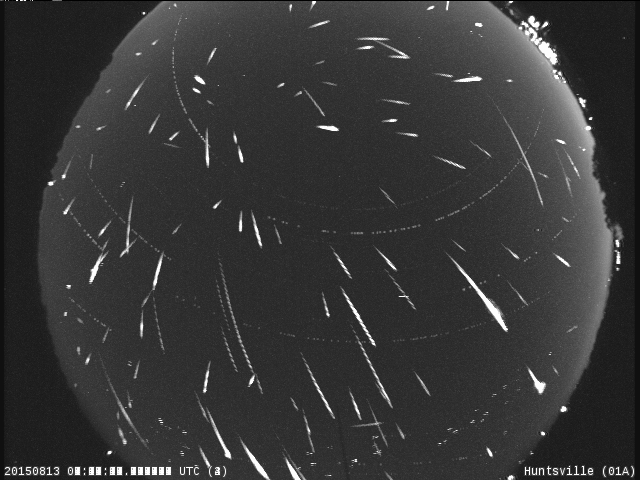A composite image combines about 120 meteor images taken by the NASA All Sky Fireball Network station at Marshall Space Flight Center in Huntsville, Ala. on August 13, 2015. The majority of the meteors are Perseids. Danielle Moser of the Meteoroid Environment Office compiled the composite image.
Month: August 2015
Perseids Are Already Appearing in the Huntsville Sky
This composite image shows the meteors detected by the NASA All Sky Fireball Network station here in Huntsville, Alabama this morning. The majority of the meteors are Perseids, but a handful belong to the Northern Delta Aquariid, Southern Delta Aquariid, Alpha Capricornid, and Southern Iota Aquariid meteor showers that are also active.
This Perseid meteor was observed by the NASA Wide-field Meteor Camera Network in the skies over Huntsville, Alabama on the morning of August 12.
Perseid Fireball Over New Mexico
Meteor Moment: What is the All-Sky Camera Network?
Dr. Bill Cooke, of NASA’s Meteroid Environment Office — located at NASA’s Marshall Space Flight Center in Huntsville, Alabama — explains what the All-Sky Camera Network is and how it’s used to track meteors or fireballs.
Meteor Moment: How to Watch the Perseid Meteor Shower
Rhiannon Blaauw, of NASA’s Meteoroid Environment Office — located at NASA’s Marshall Space Flight Center in Huntsville, Alabama — shares some tips and strategies to best view a meteor shower.
Perseids Are Already Zipping Across the Sky!
NASA Marshall to Host Ustream Event About Perseid Meteor Shower August 12; Experts to Answer Questions Online
Enjoy a summer evening of sky watching as the annual Perseid meteor shower peaks on the night of August 12 through the morning of August 13. Join meteor experts from NASA’s Marshall Space Flight Center for live Ustream commentary during the shower. Perseid meteor rates can get as high as 100 per hour, with many fireballs visible in the night sky
How to View the Perseid meteor shower
The best opportunity to see the Perseid meteor shower is during the dark, pre-dawn hours of August 13. The Perseidss streak across the sky from many directions. For optimal viewing, find an open skyline, where you can view the horizon without obstructions, such as buildings or trees. Try to view the Perseids as far away from artificial lights as possible. The darker the sky, the better viewing experience you can have. Lie on the ground and look straight up. Remember, your eyes can take up to 30 minutes to adjust to the darkness, so allow plenty of time for your eyes to adjust.
About the Perseids
The Perseids have been observed for at least 2,000 years and are associated with the comet Swift-Tuttle, which orbits the sun once every 133 years. Every August, the Earth passes through a cloud of the comet’s debris. This debris field consists of bits of ice and dust — most over 1,000 years old — and burns up in Earth’s atmosphere to create one of the best meteor showers of the year. The Perseids can be seen all over the sky, but the best viewing opportunities will be across the northern hemisphere. Those with sharp eyes will see that the meteors radiate from the direction of the constellation Perseus.
NASA Ustream: Observe the Perseid Meteor Shower
On Aug. 12, NASA’s Marshall Space Flight Center in Huntsville, Alabama, will host a live Ustream broadcast about the Perseid meteor shower. The event will highlight the science behind the Perseids, as well as NASA research related to meteors and comets. The broadcast will air 9 p.m. CDT Aug. 12, to 1 a.m. CDT Aug. 13 on the following Ustream channel: http://www.ustream.tv/channel/nasa-msfc
Special guests will include meteor experts Dr. Bill Cooke, Danielle Moser and Rhiannon Blaauw, all of NASA’s Micrometeoroid Office, located at Marshall. They will provide on-air commentary, as well as answer questions online, using Marshall social media accounts. Also scheduled to join the broadcast, via telephone, are experts from NASA’s Johnson Space Center, in Houston; NASA’s Goddard Space Flight Center in Greenbelt, Maryland; the American Meteor Society; the SETI Institute in Mountain View, California; and others.
There are two methods to join the online conversation during the broadcast. NASA followers can tweet questions to “@NASA_Marshall” using the hashtag “#askNASA.” Followers may also post questions on the Marshall Facebook account, replying to the 9 p.m. Aug. 12 Perseid “Q&A” post at: https://www.facebook.com/nasamarshallcenter









